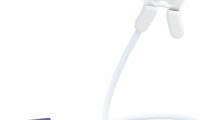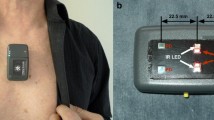Abstract
Objective. To test the accuracy of a new combined oxygen saturation and cutaneous carbon dioxide tension (SPO2–PCO2) sensor in a routine adult clinical environment. This probe provides a non-invasive and continuous monitoring of the arterial oxyhaemoglobin saturation, arterial carbon dioxide tension and pulse rate at the ear lobe. The sensor is intended to measure both relevant respiration/ventilation parameters in one single probe. Methods. Ten adult patients were consecutively studied during general anaesthesia. During the first 5 min after sensor placement at the ear lobe, arterial blood samples were drawn each minute. Carbon dioxide tension and oxygen saturation measurements were obtained simultaneously at 1-min intervals. After this period, patients were hyper-, normo- and hypoventilated. After 15 min at each setting, the simultaneously obtained cutaneous and arterial carbon dioxide tension values were compared. Results. A total of 80 comparisons between ear lobe SpO2–PCO2 measurement, finger clip pulse oximetry and arterial blood gas values were analysed. Three minutes after sensor placement, there were no significant differences between ear probe (cutaneous) and arterial carbon dioxide tensions (p = 0.367). Comparison of arterial with cutaneous carbon dioxide values demonstrated an excellent linear correlation (r2 = 0.92), and showed a standard error of estimate (SDEE) of 0.26 kPa (1.95 mmHg) only. The mean difference was −0.08 kPa (−0.60 mmHg) with a limits of agreement range of −0.38 kPa to + 0.22 kPa (−2.85 mmHg to + 1.65 mmHg). Concerning oxygen saturation measurements, the absolute SpO2 value deviated 1% or less from standard pulse oximetry. Conclusions. During general anaesthesia, postoperative recovery and critical care treatment, both monitoring of oxygenation and ventilation is important. Since pulse oximetry estimates only arterial oxygen saturation, periodic blood sampling is still necessary to determine the patient’s arterial carbon dioxide status. We could demonstrate that the difference between cutaneous and arterial PCO2 was clinically unimportant, and therefore we conclude that the two methods of estimating the patient’s carbon dioxide status may be used interchangeably. Our results demonstrated that 3 min after sensor placement, the new SpO2–PCO2 sensor prototype proved to be a reliable tool for continuous non-invasive monitoring of oxygenation and ventilation.
Similar content being viewed by others
REFERENCES
Severinghaus JW, Kellcher JF. Recent developments in pulse oximetry. Anesthesiology 1992; 76: 1018–1038
Hutton P, Clutton-Brock T. The bene¢ts and pitfalls of pulse oximetry. BritMed J 1993; 307: 457–458
Shrake K, Blonshine S, Brown R, Crapo R, Martineau R, Ruppell G, Wanger J. American Association of Respi-ratory Care, clinical practice guideline, pulse oximetry. Resp Care 1991; 36: 1406 1409
Graybeal JM, Russel GB. Capnometry in the surgical ICU: An analysis of the arterial-to-end-tidal carbon dioxide di¡erence. Resp Care 1993; 38: 923–928
Bhavani-Shankar K, Moseley H, Kumar AY, Delphi Y. Capnometry and anesthesia. Can J Anaesth 1992; 39: 617–632
Lucey IF. Clinical uses of transcutaneous oxygen moni-toring. Adv Pediatr 1981; 28: 27–56
Wimberly PD, Friis-Hansen B. The use of tc-PO2 mon-itoring in neonatal intensive care. Dan Med Bull 1981; 28: 37–40
Bucher HU, Fanconi S, Fallenstein F, Duc G. Transcuta-neous carbon dioxide tension in newborn infants: Reli-ability and safety of continuous 24-hour measurement at 42 °C. Pediatrics 1986; 78: 631–635
Weir P, Wong D, Tremper K, Zaccari J, Daves S, Patel K. Transcutaneous CO2 monitoring in adult patients at 42 °C probe temperature shows good correlation with arterial pCO2. Anesthesiology 1981; 71: A493
Robert L. Fundamentals of metrology: evaluation of instrument error and method agreement. Resp Care 1990; 35: 520–545
Bland JM, Altman DG. Statistical methods for assessing agreement between two methods of clinical measure-ment. Lancet 1986; I: 307–310
Braman SS, Dunn SM, Amico CA, Millman RP. Compli-cation of intrahospital transport of critically ill patients. Ann Internal Med 1987; 107: 469–473
Author information
Authors and Affiliations
Rights and permissions
About this article
Cite this article
Rohling, R., Biro, P. Clinical Investigation of a New Combined Pulse Oximetry and Carbon Dioxide Tension Sensor in Adult Anaesthesia. J Clin Monit Comput 15, 23–27 (1999). https://doi.org/10.1023/A:1009950425204
Issue Date:
DOI: https://doi.org/10.1023/A:1009950425204




